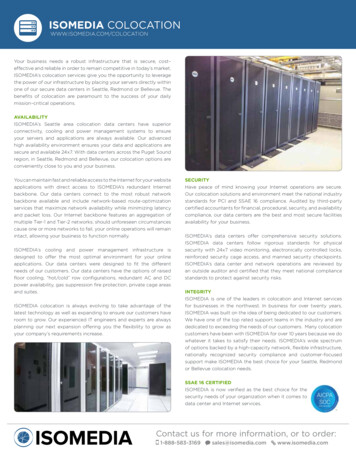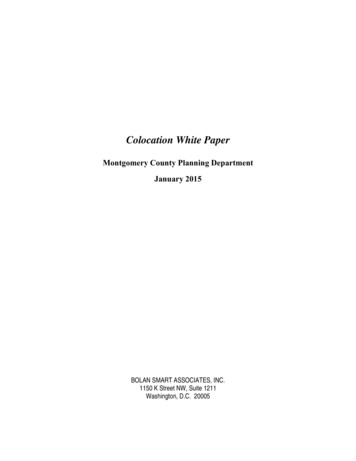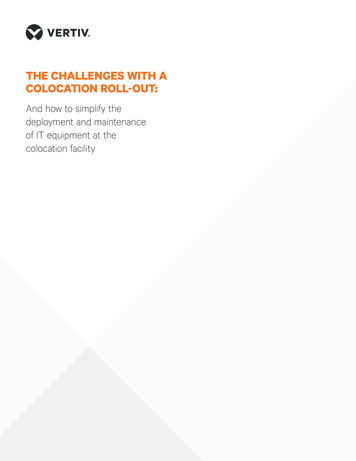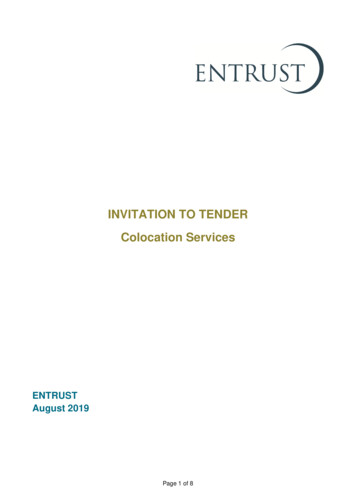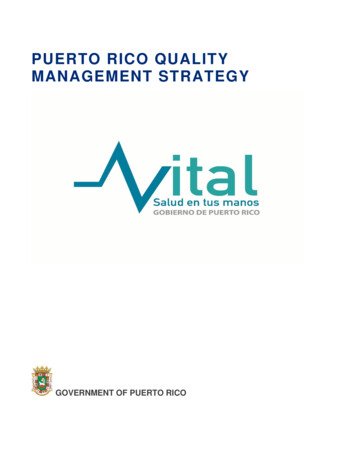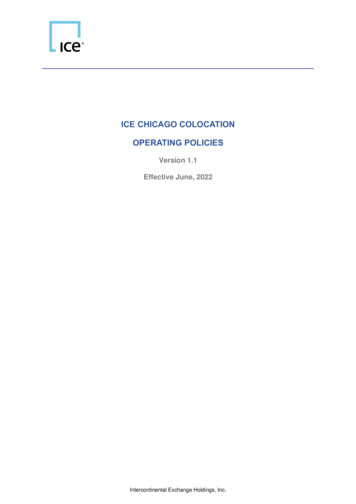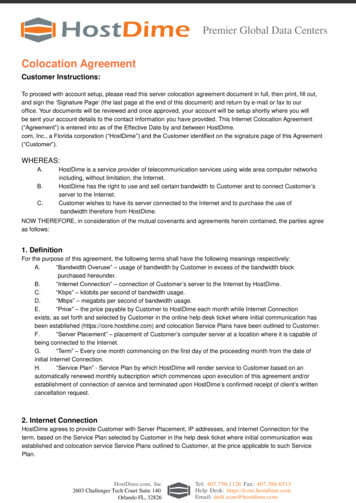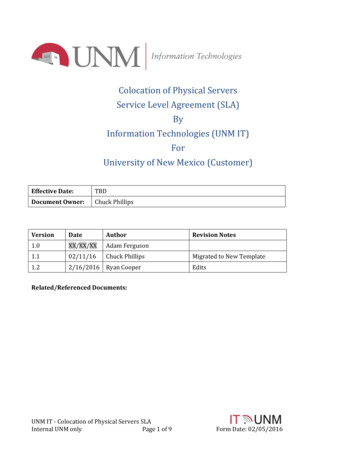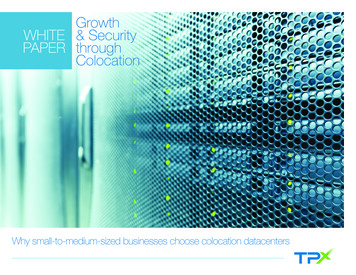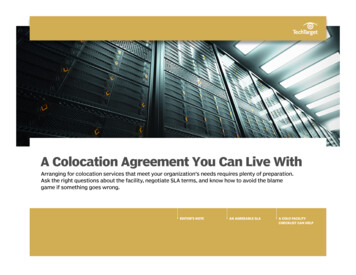
Transcription
A Colocation Agreement You Can Live WithArranging for colocation services that meet your organization’s needs requires plenty of preparation.Ask the right questions about the facility, negotiate SLA terms, and know how to avoid the blamegame if something goes wrong.EDITOR’S NOTEAN AGREEABLE SLAA COLO FACILITYCHECKLIST CAN HELP
EDITOR’SNOTEHOMEEDITOR’S NOTEAN AGREEABLE SLAA COLO FACILITYCHECKLIST CAN HELP2Getting a Provider that ProvidesAs with most things, the right amount ofpreparation in choosing a colocation providercan make a big difference in your results. Anessential part of this planning is to know whatyou’re contracting for, and how much you canget in writing.As TechTarget’s Stephen Bigelow writes inthis guide, this means negotiating a servicelevel agreement that works for your businessand not just for the provider. He delves intothe elements that make for a good workingrelationship between a business and its chosencolo provider.Specifically, Bigelow identifies four areas ofcritical importance and explains how workingon those in the early going can avoid regretsand frustrations later. Little details, such as thecustomer’s responsibility in when (and how) anoutage is reported, can matter more than youmight think.A COLOCATION AGREEMENT YOU CAN LIVE WITHAnd what about the colo facility itself? ITanalyst Clive Longbottom provides a checklistof important factors to consider when visiting and comparing colo buildings. A tour willundoubtedly present a facility in its best possible light, he notes, so you’ll want to be readywith questions that challenge the sales pitchand get to what will really help you make asound decision. Everything from access procedures to cooling techniques to network accessdeserves your attention, Longbottom writes.The colo option is a valuable one for plentyof organizations. The challenge is maximizingthe benefits and sidestepping the risks. nPhil SweeneySenior Managing EditorData Center and Virtualization Media GroupTechTarget
THE SLAAn Agreeable SLAHOMEEDITOR’S NOTEAN AGREEABLE SLAA COLO FACILITYCHECKLIST CAN HELPColocation providers are solid optionsfor businesses seeking to minimize data center investments while retaining some level ofcontrol over the computing environment. Thisform of outsourcing requires those businessesto trust their chosen providers, which is whereservice-level agreements (SLA) come into play.An SLA defines terms, outlines the scope andquality of services provided, denotes uptimeor availability for each service, limits a provider’s liabilities, and highlights other rolesand responsibilities of each party. And, if it’sunclear or unenforced, an SLA becomes a serious point of contention.that they’re intended to facilitate. These complications arise not because the provider isinept. Neither are they the fault of a customerthat’s impossibly demanding. The source ofconflict is most often the SLA itself.Too often, these agreements are written inways that simply aren’t clear enough. Theyhedge commitments with nebulous phrasessuch as “best effort.” Or they don’t adequatelyaddress key elements of the colocationrelationship.To avoid these sticking points, pay attentionto these four areas when negotiating, reviewingand signing an SLA:Poor SLAs often leave anunclear delineation of roles and responsibilities. The SLA should define the services andlevels that the parties agree upon, includingservice uptime, server availability and storagecapacity. If a provider promises server uptimenWHEN GOOD SLAs GO BADAn SLA codifies the relationship between aprovider and customer. In spite of its importance, however, SLAs are also prone to seriousproblems that can strain the very relationships3A COLOCATION AGREEMENT YOU CAN LIVE WITHResponsibilities.
THE SLAHOMEEDITOR’S NOTEAN AGREEABLE SLAA COLO FACILITYCHECKLIST CAN HELPof 99.999 percent or response times of lessthan 60 minutes, that quantifiable amountshould be written into the SLA. This sets realistic expectations—for both the customer andthe provider. “We’ve had angry customers evenwhen the response was under 10 minutes andthe resolution was under one hour,” said ScottGorcester, CEO of VirtualQube, a managed services provider near Seattle. “One client yelledthat we completely let them down despite afive-minute response and a 34-minute resolution.” SLAs should also outline a customer’sresponsibilities. For example, a customer needsto know when and how to make contact andhow to escalate problems. The customer needsto know how it will interact with the provider,whether that is through a help portal or emergency phone number. “These are details youneed to know upfront,” said Pete Sclafani, COOand co-founder of 6connect, which makesnetwork-provisioning tools. “Have them documented as part of your onboarding processwith the colo provider.”providers invariablymonitor the environment and services they’ren4Reporting. ColocationA COLOCATION AGREEMENT YOU CAN LIVE WITHproviding to customers. But providers usually don’t share all of this reporting with theircustomers. An SLA should make provisionsfor regular reporting, outlining which data acustomer will see. The SLA should also definethe points that indicate performance degradation or outages. For example, the SLA shoulddefine what is considered an “outage” and beclear about when an outage is determined tohave started. For example, Sclafani notes thatsome SLAs might require customers to phonein an outage before the customer would startreceiving outage credit (other contacts likeemail or helpdesk tickets were not consideredacceptable).SLA virtually guarantees thatcolocation providers are not liable for damagesto a customers’ business when infrastructureor services are disrupted. If an outage costs acustomer’s business 1 million in lost sales,for example, don’t expect the colocation provider to step up and write that check. At best,the customer can request a pro-rated creditfor the lost service. Let’s say a customer pays 100,000 for services over a 720-hour monthnRemediation. An
THE SLAHOMEEDITOR’S NOTEAN AGREEABLE SLAA COLO FACILITYCHECKLIST CAN HELPand lost service for two hours. Chances are thatremediation would be limited to [(100,000 /720) * 2] about 278. (And that credit mightonly be available if the customer follows thecorrect reporting process.) Even then, the colocation provider will probably not issue remediation for outages beyond its direct control.“We find that ISP problems, BGP route leakage,client-side issues or other problems, such asinclement weather, are more common causes ofclient problems than the [colocation] data center,” Gorcester said.Any business relationship mustbenefit both parties, and SLAs that are excessively rigid or non-negotiable can drive businesses away from a provider. Generally, themore volume or commodity services that aprovider offers (more closely resembling acloud provider), the more rigid an SLA willbe. But traditional infrastructure and hosting providers delivering customized resourcesor service bundles can prove far more flexiblewith SLA terms. For example, quarterly meetings between the provider and customer offerregular opportunities to talk and periodicallyn5Revisions.A COLOCATION AGREEMENT YOU CAN LIVE WITHrenegotiate terms, thereby keeping an SLArelevant.MONITORING THE SLAEven the most carefully crafted SLAs have littlevalue without comprehensive monitoring andenforcement. But monitoring and reporting areparticularly contentious aspects of colocationarrangements.Colo providers implement internal monitoring to track performance and detect problems.The challenge is that customers will likely haveconsiderably less insight into the provider’senvironment. This makes verification difficult.If the provider offers infrastructure and thecustomer is in the IT cages installing equipment and software, it’s a relatively straightforward matter for the customer to selectfrom any number of data center infrastructuremanagement (DCIM) tools. A customer canuse these tools to assess its own hardware andsoftware but also to arrange instrumentation(temperature, humidity, moisture, power, andso on) to spot-check the provider’s building. Insome cases, a customer can extend an existing
THE SLAHOMEEDITOR’S NOTEAN AGREEABLE SLAA COLO FACILITYCHECKLIST CAN HELP6tool in the local data center to the provider’sremote location with additional nodes andinstruments.Monitoring can be more problematic whena colocation provider offers hosting services.In this situation, they are providing the hardware and software that customers rent. It’s theprovider that monitors the building, hardwareand applications, and customers see far fewerreporting details. This means a customer willhave little direct insight into what’s actuallyhappening in the provider’s data center.Look for reporting data from the providerand understand the information being shared(and be suspicious of reporting that is alwaysperfect). Now consider ways to check the provider’s reporting.Sclafani notes that some providers’ monitoring systems can be accessed using applicationprogramming interfaces, allowing a customer’smonitoring tools to see what the provider sees.“We expect to see API use increase and becomea differentiator for colocation transparency.”If APIs aren’t available, evaluate the usefulness of third-party monitoring. This wouldinclude products such as op5 Monitor andA COLOCATION AGREEMENT YOU CAN LIVE WITHservices such as Uptrends and Apica.Regardless of the monitoring or reporting inplace, customers should also keep a close watchover incident reporting and response times tohelpdesk tickets, phone or email support, escalation adherence and other support. The ruleof caveat emptor (buyer beware) applies. “Theburden is on you to monitor and hold the colocation vendor accountable,” Sclafani said.DON’T OVERLOOK REALITYAny evaluation of a colocation provider’s SLAmust also include a healthy dose of commonsense and research. Can the colocation provideractually deliver what is promised?Sclafani notes that some colocation providersadvertise far better capabilities than the facility’s technical specifications support. “There areplenty of examples of ‘Tier X’ data centers,” hesaid. “But when you dig into the specificationsof the facility, they are really ‘Tier X-2.’ ”So don’t be afraid to tour colocation facilities, meet staff and ask challenging questionsbefore finalizing any SLA. Your business maydepend on it. —Stephen J. Bigelow
FACILTYCHECKLISTHOMEEDITOR’S NOTEAN AGREEABLE SLAA COLO FACILITYCHECKLIST CAN HELPA Colo Facility Checklist Can HelpIf you’ve decided that colocation is theright direction for your business, the nextstep is choosing the right provider. Evaluatingpotential colo partners means scrutinizing thefacility itself, looking closely at network access,cooling, resiliency and other essential details.Making the decision to move to a colocationfacility is becoming easier. Choosing the rightone is where the difficulty lies.Given the scope of the investment and thecomplexity of moving all that equipment, itmakes sense to have a thorough vetting process in place before making a decision. Here’s achecklist to help with that process:been to the facility, walked around and seen it in all its pristine glory. But ask yourself: Will that buildingbe big enough to accommodate not only yourgrowth, but that of the other clients the provider expects to have? If not, consider whatn7The Building’s Size. You’veA COLOCATION AGREEMENT YOU CAN LIVE WITHthat might mean to you. Think about whetheryou might eventually need to spread your platform across two facilities and whether you’recomfortable with that prospect.equipment is yourequipment. You don’t want anyone around itother than those to whom you’ve given authorization. It’s imperative that the colocationcompany thoroughly checks anyone enteringthe facility. Ask a potential provider if its stafflogs all movements around the facility. Doesthe provider enforce policies to stop entryby means of tailgating (one person followinganother through a door)? Do the cages thatcontain the IT equipment extend from floor toceiling?nBuilding Security. Yourneed to see whetherthe colocation provider has accreditations,such as ISO 27001. Look at how the companynInformation Security. You
FACILTYCHECKLISTmanages its own data. Be thorough and ask tosee its processes with regard to customer information and the vetting process for the employees who will deal directly with your assets.densities areincreasing rapidly at data centers. Your IT teammay need to double the amount of kilowattsit uses per rack or per deployment in the nextfive years. Will the colocation provider have thecapacity to do this? If not, what plans does ithave to accommodate the potential increase indemand?Backup power is another consideration, andyou’ll need the specs from any potential providers. Does it have a modular approach sothat new auxiliary generators can be added orreplaced as needed? Power failure is a looming possibility for any data center provider, soyou should check how often it runs full tests offailover plans.nHOMEEDITOR’S NOTEAN AGREEABLE SLAA COLO FACILITYCHECKLIST CAN HELPPower Provisioning. Equipmentpossible, you want a colocation facility that uses low-energy cooling. Even in parts of the world where energyprices are relatively stable, costs ebb andn8Cooling. WhereA COLOCATION AGREEMENT YOU CAN LIVE WITHflow—sometimes without warning. Thus, freeair, adiabatic or other low-energy approacheswill be better long-term bets than relyingsolely on computer room air conditioners.colocationservice providers offer fire monitoring, whichwill trigger a gas-based suppression system. Abetter option would be a colocation providerthat offers a full early-warning system. Thesesetups rely on infrared sensors to identifyemerging hot spots in equipment as well assmoke-detection (VESDA) systems, moisturemonitoring and tremble monitoring. This typeof setup allows the provider to actively takesteps to identify a problem before it affectsthe performance of the facility, or, even worse,forces a complete shutdown.nEnvironmental Monitoring. Mostcenter infrastructure monitoringand management has grown in popularity inrecent years. Within a colocation facility, youmay install your own systems managementtools that monitor and manage what your ITequipment does. However, you have little to novisibility as to what is happening around you.nDCIM. Data
FACILTYCHECKLISTHOMEEDITOR’S NOTEAN AGREEABLE SLAAptly named “noisy neighbors” may degradenetwork performance, and high-density systems could cause power problems in your sector of the facility. Colocation providers usinggood DCIM capabilities can act as overseersof the total environment, keeping an eye onthe facility’s overall performance and advisingwhere necessary as to how to better implementand run IT equipment.around power backup, look at what a colocation provider offers in platform resiliency. Canit operate your IT equipment, or hosted servers, across more than one facility? This is beneficial, as it allows you to mirror your systemsand subsequently fail over without the need forthe high impact of initiating a disaster recoveryplan.may have been able to tick allthe other requirements on this checklist, but ifyou don’t get along with the people you have tointeract with at the facility, then you will neverbe happy. Check that account management isalways available, so that you go directly to themrather than having to continually wade throughfirst- and second-line support when you knowwhat you need. —Clive LongbottomnA COLO FACILITYCHECKLIST CAN HELP9nNetwork Access. Ensurethat the facility usesmultiple network providers, and that those networks terminate at different parts of the facility. Having 10 different providers won’t matterif they all come through the same undergroundpipe that’s just been struck by a backhoe.nResiliency. Aswell as all the requirementsA COLOCATION AGREEMENT YOU CAN LIVE WITHOverall Fit. You
ABOUTTHEAUTHORSSTEPHEN J. BIGELOW, the senior technology editor in theData Center and Virtualization Media Group at TechTarget, has more than 20 years of technical writing experiencein the PC/technology industry.CLIVE LONGBOTTOM isHOMEEDITOR’S NOTEAN AGREEABLE SLAA COLO FACILITYCHECKLIST CAN HELPthe co-founder and servicedirector at Quocirca and has been an ITC industry analystfor more than 15 years. Trained as a chemical engineer,he worked on anti-cancer drugs, car catalysts and fuelcells before moving in to IT. He has worked on manyoffice automation projects, as well as Control of Substances Hazardous to Health, document managementand knowledge management projects.A Colocation Agreement You Can Live With is aSearchDataCenter.com e-publication.Margie Semilof Editorial DirectorPhil Sweeney Managing EditorLinda Koury Director of Online DesignNeva Maniscalco Graphic DesignerRebecca Kitchens Publisherrkitchens@techtarget.comTechTarget275 Grove Street, Newton, MA 02466www.techtarget.com 2016 TechTarget Inc. No part of this publication may be transmitted or reproduced in any form or by any means without written permission from thepublisher. TechTarget reprints are available through The YGS Group.STAY CONNECTED!Follow @DataCenterTT today.10A COLOCATION AGREEMENT YOU CAN LIVE WITHAbout TechTarget: TechTarget publishes media for information technologyprofessionals. More than 100 focused websites enable quick access to a deepstore of news, advice and analysis about the technologies, products and processes crucial to your job. Our live and virtual events give you direct access toindependent expert commentary and advice. At IT Knowledge Exchange, oursocial community, you can get advice and share solutions with peers and experts.COVER ART: FOTOLIA
colocation providers are not liable for damages to a customers' business when infrastructure or services are disrupted. If an outage costs a customer's business 1 million in lost sales, for example, don't expect the colocation pro-vider to step up and write that check. At best, the customer can request a pro-rated credit for the lost .
